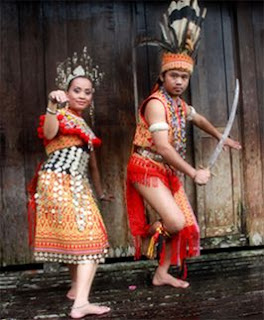Kadazan and Iban Traditional Clothes
Culture of Malaysia - traditional clothes
IBAN
The Ibans are an
indigenous community in Malaysia. They are known for their warrior-like outfits
and weaving of colourful, patterned cotton cloths called "pua
kumbu".
The
male Iban is dressed in Baju Burung or vest and sirat woven loin-cloth which is
a warrior's outfit. They also wear accessories such as a belt, armlet and
anklet made from silver and a headgear decorated with hornbill feathers. The
Iban maiden wears the ceremonial dress consisting of the bidang cloth, marek
empang which is a chest adornment, the sugu tinggi headdress and other silver
ornaments such as the coin belt and bangles. The loincloth is a garment of great
antiquity, is now distinctively ignored among modern Ibans. Barkcloth is the
original material for loincloths. The way to tying a "sirat" is take
a strip of material about 10 inches wide and 10 to 12 feet long, the end of the
cloth is decorated with beautiful embroidery or weaving. Men's traditional Iban
costumes wear “sirat” with a very long loincloth around the waist and between
the two stocks, one end through the legs hanging in front which is dress like a
apron and the other end around the waist. There should be a little “tail” (iko
sirat in Iban) in the back. The loincloth worn in this way is quite secure and
will not fall off. Furthermore, they also wear accessories such as a belt,
armlet and anklet made from silver and a headgear decorated with hornbill
feathers.
KADAZAN
Kadazan is an indegenious
ethnic group in Sabah, Malaysia. Their traditional attires are well conserved
since their past
The male Kadazan is wearing a ceremonial costume
usually worn during the Sumazau dance. It comprises of a jacket and trousers
with gold trimmings and a woven destar cloth headgear known as siga. The female
is wearing a ceremonial Kadazan Papar costume made of embroidered colour and
gold thread. It is worn with a headgear made of bamboo strips known as siung
and silver coin belt. These clothes are usually made from black velvet or silk. The gold-plated silver betawi
buttons are looped through a string on the inside. Betawi buttons used to be
fixed all the way up to the neck for ceremonial occasions and half way up from
the lower end of the blouse for daily wear. Now days, the buttons are tied
together from the top down to the bottom of the blouse with a cotton thread.
There are thirty or more gold buttons sewn in a double row on sinuangga.
“Tapi” is a long cylindrical wrap-skirt and formerly of plain black cotton. Now
days, it is often enlivened with siring which is gold trimming, running over
the hips, in front of the skirt, crossed by another band of trimming from the
waist down. A Kadazandusun lady wearing the traditional costume normally
emphasize the slimness of their waist is considered as beautiful.


Comments
Post a Comment